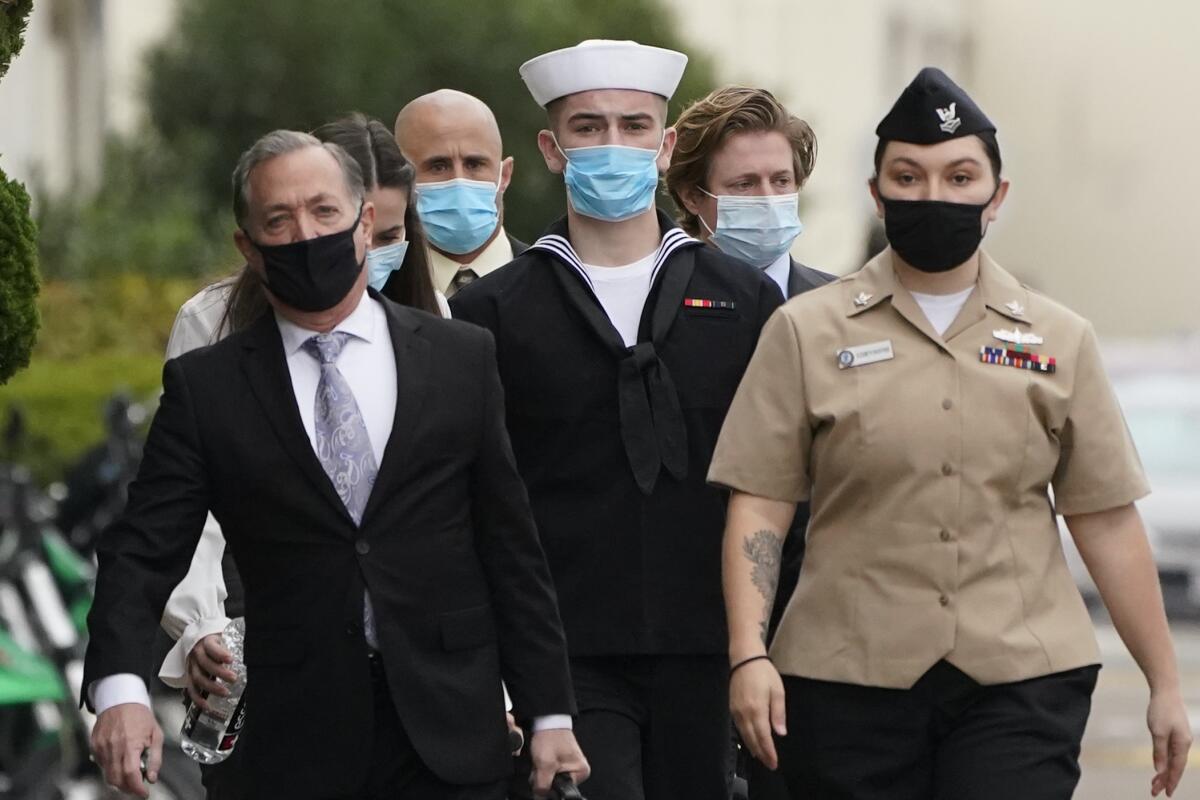Sailor charged in Navy ship fire was angry about washing out of SEALs, prosecutors say

- Share via
SAN DIEGO — A 19-year-old sailor was so disgruntled with the Navy last year after dropping out of SEAL training that he intentionally set the devastating fire aboard the amphibious assault ship Bonhomme Richard in San Diego, Navy prosecutors alleged Monday during the first day of a preliminary hearing at Naval Base San Diego.
Seaman Ryan Mays, now 20, is charged with the willful hazarding of a vessel and aggravated arson. Mays faces up to life in prison if convicted, his civilian lawyer, Gary Barthel, told the San Diego Union-Tribune in an interview Monday.
Mays denies the charges against him.
The court proceedings, known as an Article 32 hearing in the military justice system, are scheduled to continue through Thursday as Navy prosecutors work to convince a hearing officer, Navy Capt. Angela Tang, that they have enough evidence to prosecute the sailor in connection with the July 2020 fire.
On Monday, Navy prosecutors began to lay the groundwork of their case: that the fire, which burned for four days and led the Navy to scrap the ship this year, was intentionally set in the vessel’s lower vehicle storage area and that sailors onboard saw Mays going into the “Lower V” right before the blaze began.
While a junior sailor faces arson charges, a Navy investigator recommends 36 service leaders also face punishment
Prosecutors said Mays was angry about being a deck seaman aboard the ship instead of a SEAL — the job he joined the Navy to do. Prosecutors said Mays had voluntarily dropped out of the Navy’s Basic Underwater Demolition/SEAL school — known as BUD/S — on his fifth day there, then lied to his family and other sailors about why he didn’t make it.
Mays’ supervisor, Boatswain’s Mate 2nd Class Beau Benson, testified Monday that Mays was unhappy working in the deck department of the ship.
“You could tell he didn’t want to be here,” Benson said. “You could tell he didn’t enjoy being in the fleet.”
During cross-examination, Benson also said it was not unusual for sailors who were dropped from BUD/S to find themselves in deck department or for them — or other deck seamen — to be unhappy in those circumstances.
“I wouldn’t say they enjoy doing it,” Benson said.
Mays, in his dress blue “crackerjack” uniform, sat with his defense team — Barthel and two Navy lawyers — and did not react to Benson’s testimony.
Barthel said in court Monday that the stories from the former Bonhomme Richard sailors set to testify against Mays changed throughout the investigation, and the lawyer suggested they conspired to pin the blame on Mays, whom they did not like.
In an interview after the hearing, Barthel pushed back against the notion that Mays was disgruntled, saying the young sailor was working to give BUD/S another shot.
“He was determined to get back into BUD/S,” Barthel said, adding that Mays’ chain of command was aware of his goal and encouraging him.
Barthel declined to comment on his conspiracy allegation but said witness testimony over the next couple of days will lay it bare.
Prosecutors called two additional witnesses Monday: an arson investigator from the federal Bureau of Alcohol, Tobacco, Firearms and Explosives, and the sailor thought to be the last person known to have been in the Lower V that day before the fire started.
Matthew Beals, the ATF investigator, testified that the fire was started by someone holding an open flame against a tri-wall — a pallet-sized, triple-walled cardboard box — in the Lower V. The tri-walls were side by side and stacked two high that day, Beals said.
Beals testified that an accelerant, such as paint thinner or diesel fuel, could have been used as well, but he could not say for certain. A plastic water bottle smelling of diesel was found near the ignition source after the blaze was out, but it was removed by an unknown person before it could be collected for evidence, Beals said.
According to a list of witnesses from the prosecution, four more Bonhomme Richard sailors are set to testify, as well as two Naval Criminal Investigative Service special agents.
The first witness scheduled to appear Tuesday is the government’s key witness, the sailor who prosecutors say saw Mays walking with a bucket into the Lower V just before the fire began.
The fire, which started just after 8 a.m. on July 12, 2020, burned for more than four days before being declared extinguished. Federal, city and Navy firefighters struggled in the blaze’s earliest minutes to extinguish it; by the time they were able to get water hoses on board, it was all but too late for the ship, according to a separate Navy investigation.
The investigation found that failures among 36 service leaders contributed to the destructiveness of the fire — the ship’s fire stations were in poor condition after two years in the maintenance yard, and its sailors had not kept up their firefighting training.
More to Read
Sign up for Essential California
The most important California stories and recommendations in your inbox every morning.
You may occasionally receive promotional content from the Los Angeles Times.












